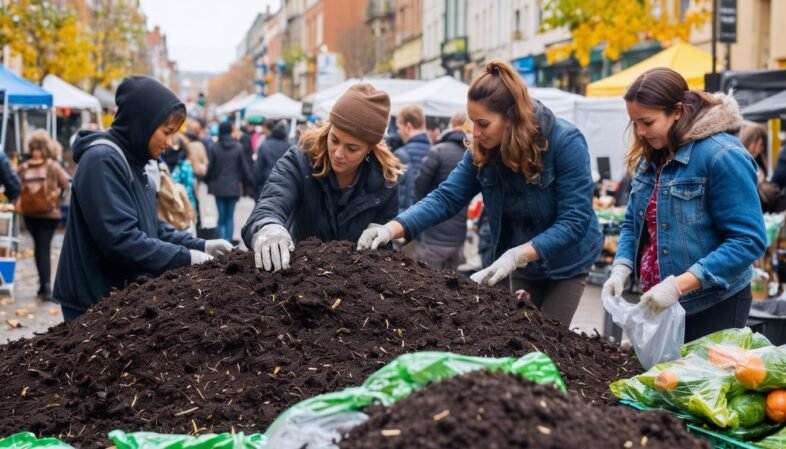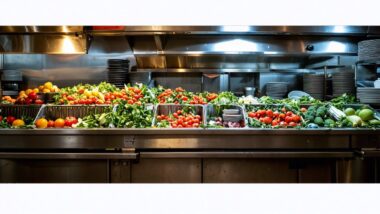Learn “What is Commercial Composting?” plus 7 Surprising Benefits Of Commercial Composting As A Green Waste Disposal Solution

Dealing with green waste can be costly and challenging for many businesses. Did you know that commercial composting can solve this problem while offering unexpected benefits? In this blog, we'll explore how turning organic material into compost can lead to cost savings, new revenue streams, improved soil quality, and more.
Discover the surprising perks of commercial composting!
Definition of Commercial Composting
Here's a definition of commercial composting and home composting, along with a comparison of the two methods:
Commercial Composting
Commercial composting involves large-scale organic waste processing facilities that turn food scraps and yard trimmings into nutrient-rich compost. These facilities collect organic waste from businesses, restaurants, and sometimes households.
Home Composting
Home composting is a small-scale process of turning food scraps and yard waste into compost in your backyard or designated composting bin. It's a natural way to reduce kitchen waste and create a valuable soil amendment.
Comparison of Commercial and Home Composting
| Feature | Commercial Composting | Home Composting |
|---|---|---|
| Scale | Large-scale facilities handling tons of organic waste | Small-scale process for individual households |
| Collection | Organic waste is collected from various sources | You add your own food scraps and yard trimmings to the compost bin |
| Complexity | Requires specialized equipment and expertise to manage large-scale composting processes | Relatively simple process with minimal tools or equipment needed |
| End product | Produces large quantities of compost that may be sold commercially or used for landscaping purposes | Creates compost for personal use in your garden or potted plants |
| Sustainability | Could be better: Far lower environmental and climate change impact than disposal to landfill, but is not as beneficial as anaerobic digestion (AD) because AD also extracts the sun's energy as useable biogas (renewable methane). | Not preferred, because most gardeners fail to turn and aerate their compost piles adequately. The result is a very damaging greenhouse gas is emitted to the atmosphere. |
Key Takeaways
- Cost Savings and Revenue Generation: Bylands Nurseries saved over $400,000 annually on landfill fees by adopting commercial composting. They also created new revenue streams by selling bagged compost to customers.
- Enhanced Soil Quality: Using nutrient-rich compost instead of chemical fertilisers, Bylands improved soil quality. This led to healthier plants with stronger roots and higher yields equivalent to 40 extra acres of plant production each year.
- Sustainable Practices and Industry Leadership: Bylands' commitment to composting started in 2000, earning them multiple awards such as the International Grower of the Year Award. Their sustainable practices have set industry standards for environmental stewardship.
- Reduction in Waste Disposal Fees: The nursery significantly reduced its waste disposal costs due to increased municipal landfill charges ($40 per ton) by switching to a cost-effective composting solution.
- Environmental Benefits: Composting helped reduce methane emissions associated with landfill use. It also promoted cleaner farming practices by offering an eco-friendly solution that supports a circular economy through recycling organic materials into valuable products.
The Success Story of Bylands Nurseries in Embracing Composting

Bylands Nurseries started a commercial composting program in 2010. They saw major savings on waste disposal fees and improved revenue by selling compost products while enhancing plant quality and soil health.

Implement Commercial Composting Program
Bylands Nurseries started composting their green waste in 2000. They carried out a cost-benefit analysis before starting the program. Here’s how they implemented their commercial composting program:
- Cost-Benefit Analysis: Conducted a thorough cost-benefit analysis to understand feasibility. Evaluated potential savings and expenses involved.
- Invest in Equipment: Purchased necessary machinery for composting tasks. This included shredders and turners for managing large compost piles.
- Allocate Labour: Hired staff trained in composting processes. Ensured they were skilled in handling organic waste effectively.
- Address Municipal Landfill Charges:
Faced increased landfill charges of $40 per ton, making alternative solutions crucial. Byelands chose composting to mitigate these costs. - Produce Compost Annually: Now generates 18,300 meters of compost each year. Utilises this compost within their operations, reducing external dependencies.
- Replace Peat Moss: Substituted peat moss with the produced compost in potting mixes. Reduced transportation costs by using home-grown materials.
- Boost Soil Quality: Enhanced soil quality by enriching it with nutrient-rich compost. This led to healthier plant production and improved yields.
- Promote Sustainable Practices: Adopted sustainable waste management practices that benefited both business and the environment. Positioned themselves as industry leaders in environmental sustainability. via Theglobeandmail.com
Achieve Reduction in Waste Disposal Fees
Disposal fees dropped significantly due to the new composting program. Municipal landfill charges were $40 per ton of waste. This programme has led to savings of over $400,000 annually in operating costs.
The cost-benefit analysis highlighted these potential savings.
Savings also come from reduced material hauling expenses and avoiding rising landfill tipping fees. “The compost program saves us millions,” says a Bylands Nurseries manager. This green solution benefits both the environment and the budget, contributing to sustainable agricultural practices.
Switching to composting has been a game changer for our nursery.
Boost Quality and Revenue through Composting
Bylands Nurseries boost quality and revenue through composting. They bag portions of their compost and sell it to customers, providing a new stream of income. The nursery found that the compost proved more nourishing than chemical fertiliser.
This improved soil quality led to better trees and plants.
Thanks to enhanced soil, Bylands gained an equivalent of 40 acres of extra plant production every year. Savings on chemical fertilisers also contribute significantly, reducing costs while improving output.
Compost products create strong plants with natural pest control benefits, making them greener choices for eco-conscious consumers.
Exploring the Benefits of Commercial Composting for Green Waste Management
Commercial composting offers many benefits for managing green waste. It can save money and improve soil quality, which helps plants grow better.

1. Realise Cost Savings with Composting
Bylands Nurseries achieved annual savings exceeding $400,000 through composting. They avoided $40 per ton landfill tipping fees and cut down on transportation costs. Replacing peat moss with nutrient-rich compost further reduced expenses.
Operating cost reductions were significant due to less reliance on chemical fertilisers. The nourishing organic matter from compost provides the necessary nutrients for plants at lower costs.
This cost-benefit analysis justified the initial investment in commercial composting programmes.
2. Generate New Revenue Streams from Compost Products
Bylands Nurseries found a goldmine in their compost products. They bag and sell portions of their compost to customers, creating new revenue streams. This addition boosts the nursery's income while promoting sustainability.
Marketing these compost products proved successful and profitable.
Selling compost contributes to a circular economy by recycling organic materials into valuable soil enhancers. Farmers avoid landfill costs and reduce methane emissions with each bag sold.
“Composting is an opportunity to turn waste into wealth,” said by an industry expert.
Composting is an opportunity to turn waste into wealth.
3. Enhance Soil Quality via Compost Use
Compost enriches soil more effectively than chemical fertilisers. It contains organic matter that improves the soil's structure, allowing it to retain water and nutrients better. Using compost enhances soil fertility, making plants healthier and more productive.
This leads to higher yields of crops such as trees and other plants.
Plants grow stronger roots due to improved soil quality from compost use. Frequent planting becomes possible because composted soils maintain their nutrient levels longer compared to those treated with traditional amendments.
Compost also replaces less efficient soil treatments, boosting overall plant production significantly.
– Amplify Plant Production with Improved Soil
4. Amplify Plant Production with Improved Soil
Using compost can greatly enhance plant production. Bylands Nurseries saw their annual plant production rise by the equivalent of 40 acres after adopting commercial composting. Better soil boosts more frequent planting cycles, allowing for consistent yields.
Healthy soil from compost provides essential nutrients to plants. This creates a nourishing environment for growth and supports sustainable food production. With improved soil quality, plants grow stronger and healthier, demonstrating reduced need for chemical fertilisers and fewer incidences of pests.
5. Gaining Recognition and Awards for Environmental Leadership
Companies that adopt sustainable practices often lead their industry. They can earn awards for their achievements in composting and green waste management.

6. Lead the Industry with Sustainable Practices
Bylands Nurseries started composting in 2000. Their commitment has made them leaders in sustainability. This programme has also earned them accolades for its environmental impact. By adopting composting, they have improved soil quality and cut waste disposal fees.
Many nurseries look up to Bylands' model for their green practices. Compost products enrich the soil better than chemical fertilisers, boosting plant growth and reducing greenhouse gas emissions.
Adopting similar sustainable initiatives can help your nursery save costs while supporting the fight against climate change.
7. Earn Accolades for Composting Achievements
Bylands Nurseries set a stellar example in the composting field. They bagged the BC Nursery Grower of the Year Award in 2010, followed by the Canadian Nursery Grower of the Year Award in 2011.
Their crowning achievement came when they received the International Grower of the Year Award in 2012. These accolades reflect their dedication to sustainable practices and innovative waste management solutions.
Their commitment has brought them multiple awards and industry recognition for leadership. By implementing eco-friendly techniques, they have showcased how successful green initiatives can be within commercial operations.
Earn respect and gain visibility by adopting similar strategies that benefit not just your business but also our planet.
Lead your industry with sustainable practices next…
Conclusion
Commercial composting transforms waste into wealth. Companies like Bylands Nurseries have achieved significant cost savings. They improve soil quality and boost plant production. The process is straightforward and highly effective.
Embrace this green solution for a sustainable future in agriculture.
FAQs
1. What is commercial composting?
Commercial composting is a method where food waste and garden waste are collected and decomposed to create rich soil.
2. How does commercial composting help the environment?
Commercial composting reduces landfill use, lowers greenhouse gas emissions, and helps combat climate change by turning waste into useful products like mulch.
3. Can businesses benefit from using commercial composting?
Yes! Businesses can improve their reputation, comply with environmental regulations, and support sustainable growth by using industrial composters for green waste disposal.
4. What types of materials can be used in commercial composting?
Materials like food scraps, plant-based packaging, manure, bioplastic items that biodegrade quickly, and household rubbish can all go into a large-scale composter or anaerobic digester.
5. Are there different methods of commercial composting?
Yes! Methods include windrow composting which involves piling organic matter in long rows; in-vessel systems that decompose material inside containers; vermicomposting which uses worms; and anaerobic digestion that produces biogas as it breaks down organic material without oxygen.
6. Why should companies consider on-site versus off-site commercial composting solutions?
On-site options reduce transport costs whilst providing immediate access to fresh fertiliser for landscaping needs whereas off-site solutions might better handle larger volumes through advanced recycling infrastructure ensuring zero-waste goals are met effectively.






